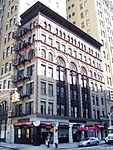Santos Party House
Santos Party House was a New York City nightclub located at 96 Lafayette Street between Walker and White Streets in the TriBeCa neighborhood of downtown Manhattan. Originally named the "Lafayette Street Jungle Gym", Santos Party House was recognized as the "Best New Nightclub" by Paper magazine's Annual Nightlife Awards, and has also won awards for its parties, sound system, lighting, and dance floor. The nightclub was a two-level, 8,000-square-foot (740 m2) music venue designed by Ronald Castellano to function as a concert hall, dance club, and lounge. It took the partners, including noted musician Andrew W.K., three years to acquire a cabaret license and finish the creation of the space, with the downstairs space opening on May 14, 2008, and the upstairs space opening on June 1, 2008. In total, the venue features three bars, black walls and ceilings, dark wood floors, tall columns, and an array of ever-changing decorations.Santos Party House's last night of operation was May 29, 2016, on which it hosted the controversial punk festival Oi! Fest. The venue received backlash due to Oi! Fest's association with neo-Nazism.
Excerpt from the Wikipedia article Santos Party House (License: CC BY-SA 3.0, Authors).Santos Party House
Lafayette Street, New York Manhattan
Geographical coordinates (GPS) Address Website Nearby Places Show on map
Geographical coordinates (GPS)
| Latitude | Longitude |
|---|---|
| N 40.71768 ° | E -74.00137 ° |
Address
New York City Rescue Mission
Lafayette Street 90
10278 New York, Manhattan
New York, United States
Open on Google Maps









